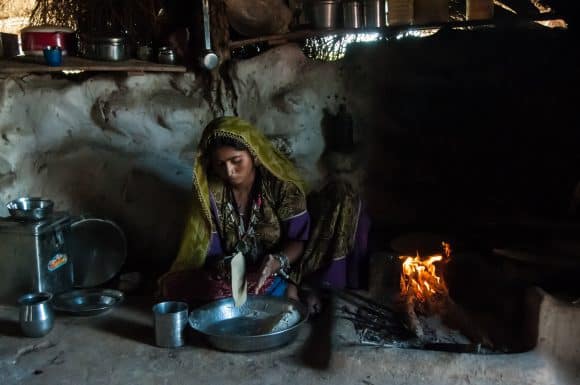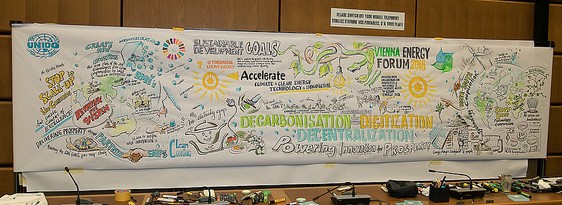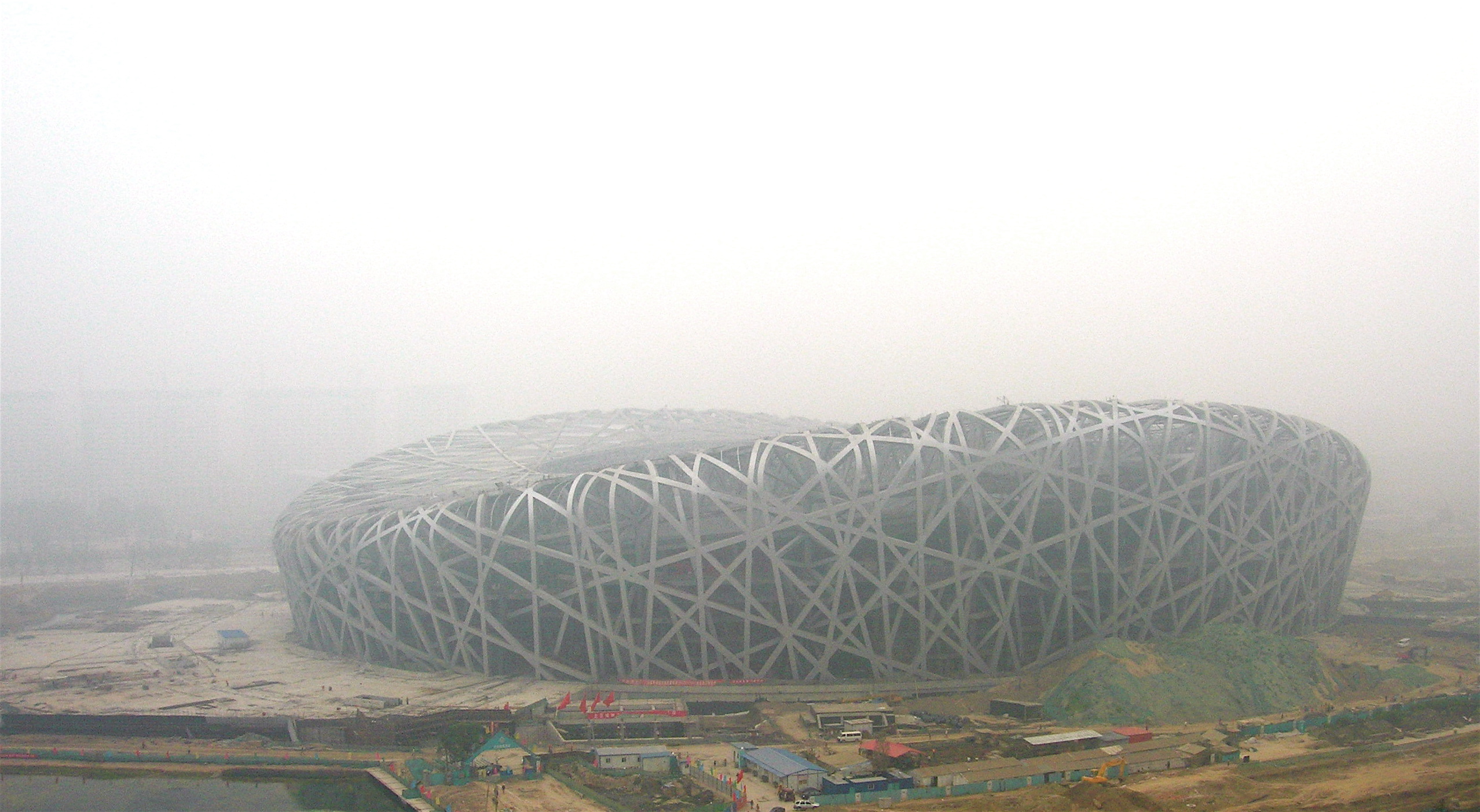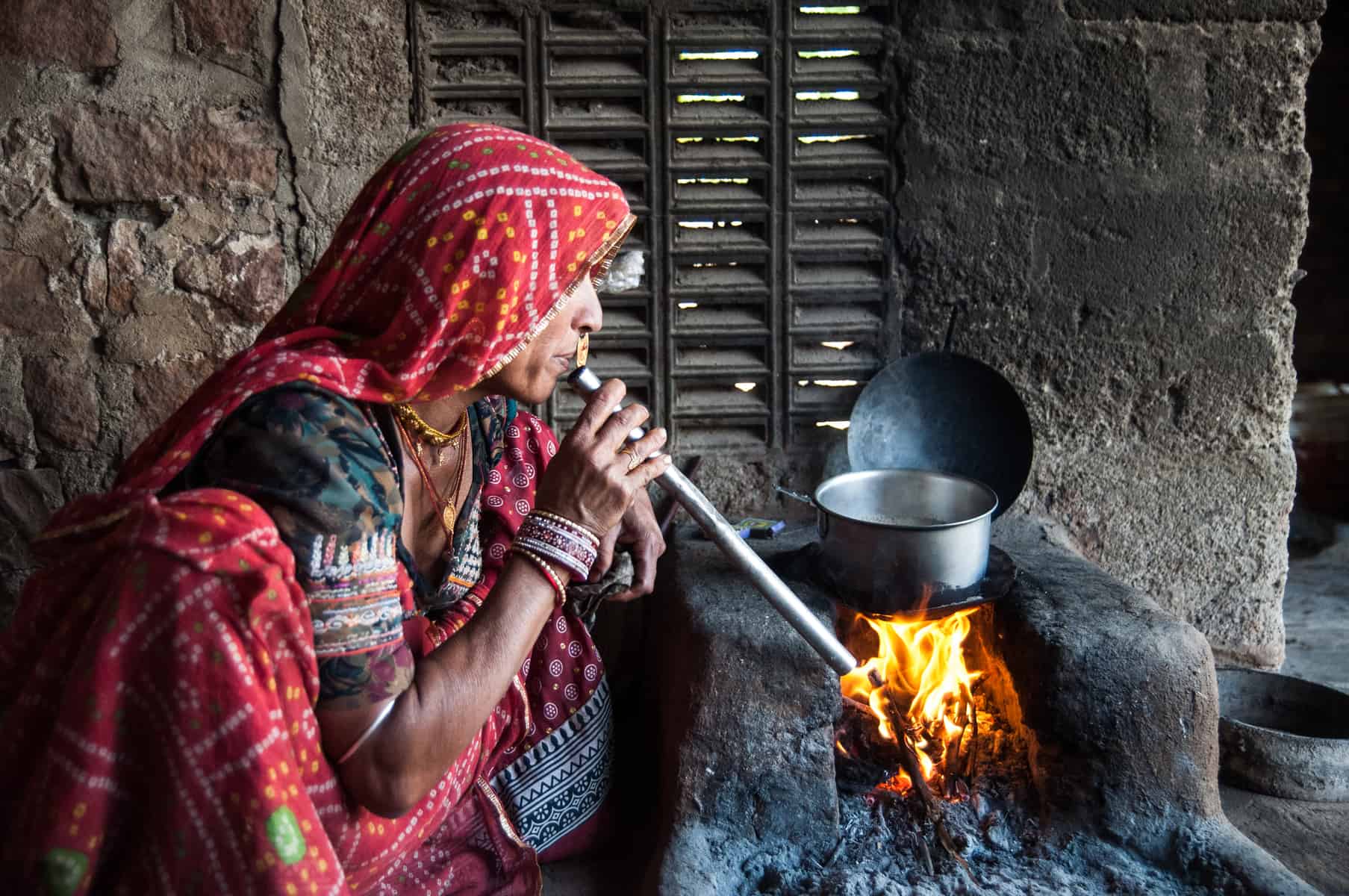Jul 17, 2018 | Air Pollution, Energy & Climate, Poverty & Equity, Women in Science, Young Scientists

© Stefano Barzellotti | Shutterstock
By Sandra Ortellado, IIASA Science Communication Fellow
When it comes to home cooking in rural India, health, behavior, and technology are essential ingredients.
Consider the government’s three-year campaign to reduce the damaging impacts of solid fuels traditionally used in rural households below the poverty line.
Initiated by the Ministry of Petroleum and Natural Gas, a program called Pradhan Mantri Ujjwala Yojana (Ujjwala) aims to safeguard the health of women and children by providing them access to a clean cooking fuel, liquid petroleum gas (LPG), so that they don’t have to compromise their health in smoky kitchens or wander in unsafe areas collecting firewood.
According to the World Health Organization, smoke inhaled by women and children from unclean fuel is equivalent to burning 400 cigarettes in an hour.
Nevertheless, an estimated 700 million people in India still rely on solid fuels and traditional cooking stoves in their homes. A subsidy of Rs. 1600 (US $23.47) and an interest free loan attempts to offset the discouraging cost of the upfront security deposit, the stove, and the first bottle of LPG, but this measure hasn’t been able to change habits on its own.
Why? Although the government has made an overwhelming effort to increase access, interconnected factors like cultural norms, economic trade-offs, and convenience require an in-depth analysis of human behavior and decision-making.

Abhishek Kar, 2018 YSSP participant ©IIASA
That’s why Abhishek Kar, a researcher in the IIASA Energy Program and a participant in the 2018 Young Scientists Summer Program (YSSP), has designed a study to explore how rural households make choices about access and usage. Borrowing from behavior change and technology adoption theories, he wants to know whether low-cost access is enough incentive for Ujjwala beneficiaries to match the general rural consumption trends, and more importantly, how to translate public perception into a behavior change.
“I think it’s really important to look into the behavioral aspect,” said Kar in an interview. “If you ask someone if they think clean cooking is wise they may say yes, but if you say do you think it is appropriate for you? The moment it becomes personalized the answers can vary.”
Kar knows that although more than 41 million LPG connections have been installed, installment of the connection does not necessarily equate to use. By gathering data on LPG refill purchases and trends, along with surveys that identify biases in the public’s perception, he wants to know how to convince rural BPL households to maintain the habit of using LPG regularly, even under adverse conditions like price hikes. If LPG is used only sporadically, LPG ownership won’t significantly reduce risk for some household air pollution (HAP)-linked deadly diseases, like lower respiratory infections and stroke.
Unfortunately, even the substantial efforts the government has made to improve LPG supply has not changed the public’s perception of its accessibility in the long term, nor its consumption patterns in the first two years. At least four LPG refills per year would be needed for a family of five to use LPG as a primary cooking fuel, which is not currently happening for the majority of Ujjwala customers.
Because the majority of Ujjwala beneficiaries have cost-free access to solid fuels from forest and agricultural fields, there is less incentive for these families to use LPG regularly instead of sporadically. Priority households for Ujjwala, especially those with no working age adults, are often severely economically disadvantaged and can’t afford to buy LPG at regular intervals.
Furthermore, unlike LPG, a traditional mud stove is more versatile and can serve dual purposes of space heating and cooking during winter months. Many prospective customers are also hesitant about the inferior taste of food cooked in LPG, the utility of the mud stove’s smoke as insect repellent, and the trade-off of expenses on tobacco and alcohol with LPG refills.
As per past studies, even the richest 10% of India’s rural households (most with access to LPG) continue to depend on solid fuels to meet ~50% of their cooking energy demand. This suggests that wealth is not the only stumbling block in the transition process.
“Whatever factors matter in the outside world, my working hypothesis is that every decision is finally mediated through a person’s attitude, knowledge, and perceptions of control,” said Kar. According to Kar, interventions can be specifically targeted to address factors that are perceived negatively either by informing people or doing something to improve that factor. Nevertheless, developing effective interventions is no simple task.
Even with a background in physics and management and eight years of experience helping people transition from one technology to another, Kar says he is grateful to have the input of a variety of scholars at IIASA, each with a different perspective and a different set of core skills and experiences. Working in the Energy program alongside IIASA staff and fellow YSSPers from all over the world, Kar puzzles out the unsolved challenge of how to create change for the rural poor.
“That has been one of my drivers, I take it as an intellectual challenge,” said Kar. “Is there a systems approach to the problem?”
For now, Kar is happy if he can return at the end of the day to his family, which he brought with him to Austria during his time as a YSSP participant, feeling like he is opening the door to a vast literature on technology adoption and human behavior, yet untapped in the field of cooking energy access.
“This research is only a very small baby step into trying something different,” said Kar, “I think this sector has so many unanswered questions, if I can at least flag that there is a lot of literature out there in other domains and maybe we can use some of it, I think that would be good enough for me.”
Note: This article gives the views of the author, and not the position of the Nexus blog, nor of the International Institute for Applied Systems Analysis.
May 28, 2018 | Air Pollution, Climate, Climate Change, Ecosystems, Energy & Climate, Women in Science
By Beatriz Mayor, Research Scholar at IIASA
On 14 and 15 May, Vienna hosted two important events within the frame of the world energy and climate change agendas: the Vienna Energy Forum and the R20 Austrian World Summit. Since I had the pleasure and privilege to attend both, I would like to share some insights and relevant messages I took home with me.

Beatriz Mayor at the Austrian World Summit © Beatriz Mayor
To begin with, ‘renewable energy’ was the buzzword of the moment. Renewable energy is not only the future, it is the present. Recently, 20-year solar PV contracts were signed for US$0.02/kWh. However, renewable energy is not only about mitigating the effects of climate change, but also about turning the planet into a world we (humans from all regions, regardless of the local conditions) want to live in. It is not only about producing energy, about reaching a number of KWh equivalent to the expected demand–renewables are about providing a service to communities, meeting their needs, and improving their ways of life. It does not consist only of taking a solar LED lamp to a remote rural house in India or Africa. It is about first understanding the problem and then seeking the right solution. Such a light will be of no use if a mother has to spend the whole day walking 10 km to find water at the closest spring or well, and come back by sunset to work on her loom, only to find that the lamp has run out of battery. Why? Because her son had to take it to school to light his way back home.
This is where the concept of ‘nexus’ entered the room, and I have to say that more than once it was brought up by IIASA Deputy Director General Nebojsa Nakicenovic. A nexus approach means adopting an integrated approach and understanding both the problems and the solutions, the cross and rebound effects, and the synergies; and it is on the latter that we should focus our efforts to maximize the effect with minimal effort. Looking at the nexus involves addressing the interdependencies between the water, energy, and food sectors, but also expanding the reach to other critical dimensions such as health, poverty, education, and gender. Overall, this means pursuing the Sustainable Development Goals (SDGs).

Vienna Energy Forum banner created by artists on the day © UNIDO / Flickr
Another key word that was repeatedly mentioned was finance. The question was how to raise and mobilize funds for the implementation of the required solutions and initiatives. The answer: blended funding and private funding mobilization. This means combining different funding sources, including crowd funding and citizen-social funding initiatives, and engaging the private sector by reducing the risk for investors. A wonderful example was presented by the city of Vienna, where a solar power plant was completely funded (and thus owned) by Viennese citizens through the purchase of shares.
This connects with the last message: the importance of a bottom-up approach and the critical role of those at the local level. Speakers and panelists gave several examples of successful initiatives in Mali, India, Vienna, and California. Most of the debates focused on how to search for solutions and facilitate access to funding and implementation in the Global South. However, two things became clear. Firstly, massive political and investment efforts are required in emerging countries to set up the infrastructural and social environment (including capacity building) to achieve the SDGs. Secondly, the effort and cost of dismantling a well-rooted technological and infrastructural system once put in place, such as fossil fuel-based power networks in the case of developed countries, are also huge. Hence, the importance of emerging economies going directly for sustainable solutions, which will pay off in the future in all possible aspects. HRH Princess Abze Djigma from Burkina Faso emphasized that this is already happening in Africa. Progress is being made at a critical rate, triggered by local initiatives that will displace the age of huge, donor-funded, top-down projects, to give way to bottom-up, collaborative co-funding and co-development.
Overall, if I had to pick just one message among the information overload I faced over these two days, it would be the statement by a young fellow in the audience from African Champions: “Africa is not underdeveloped, it is waiting and watching not to repeat the mistakes made by the rest of the world.” We should keep this message in mind.
Aug 31, 2017 | Air Pollution, Health
By Caroline Njoki, IIASA Science Communication Fellow 2017
The Olympic Games creates a spectacle that enthralls the world every four years. Countries enter a competitive bidding process to select a new host, hoping to enhance their international image and attract tourism. Among many other preparations, the host nation commits to meeting recommended air quality standards to safeguard the health of athletes, visitors, and residents.
Studies indicate that air pollution can affect performance and compromise the health of those engaged in competitive sports and outdoor physical activities. Through his presentation at IIASA in July, Professor Tong Zhu from the College of Environmental Sciences and Engineering at Peking University expounded on health effects arising from a major air pollutant: particulate matter measuring 2.5 microns or less, known as PM2.5.

The Bird’s Nest Stadium, Beijing Olympics 2008 © rytc | flickr
PM2.5 is made up of fine particles smaller than human hair, pollen or mold. These tiny particles are released into the atmosphere from many sources: burning solid fuels and waste, wildfires, emissions from industry, vehicles, construction and mining, volcanic eruptions, and dust. ‘‘It is difficult to tackle particulate matter as its chemical composition changes when it mixes with other substances in the air. It can also be transported far from the different sources depending on weather conditions and topography,’’ said Zhu.
Once inhaled, the minute particles travel deep into the lungs and enter the bloodstream, leading to impaired brain, respiratory, and heart function. Lung cancer, stroke, chronic obstructive pulmonary disease and lowered life expectancy are all associated with PM2.5 exposure. Taking part in oxygen-demanding physical activities such as long-distance races, jogging, and cycling requires breathing more through the mouth than nose. This increases the likelihood of inhaling harmful pollutants, especially in areas where concentrations are high.

Hosting international sport events such as the Olympics Games comes with commitment to improve air quality standards to safeguard the health of athletes, visitors, and residents © Pete Niesen | Shutterstock
China is a densely populated and industrialized country with coal as the main source of energy. Eighty-three percent of China’s population live in regions whose PM2.5 levels exceed World Health Organization’s guidelines, compared to 32% of the world population. Use of coal for domestic heating goes up during the winter, generating more particulate matter pollution indoors. In 2010, 1.2 million people died in China as a result of particulate matter pollution; it was the country’s fourth leading cause of death after diet, high blood pressure, and smoking. ‘‘Electricity would be a better option but is highly priced, hence the preference for biomass fuels by residents. Phasing out coal and switching to renewable energy and cleaner production technologies would greatly alleviate the problem,’’ said Zhu.
Zhu was involved in several initiatives to improve air quality in preparations for the 2008 Beijing Olympics. Measures included temporary relocations of more polluting industries and complete shutdown of coal plants, limiting construction projects, and transport restrictions. For instance, public transport and cycling was promoted to cut the number of vehicles on the road and reduce emissions.
Although short term, steps taken to reduce PM2.5 and other pollutants also benefited locals living in Beijing and adjacent cities that were selected as sporting and training venues. This meant fewer people seeking outpatient and inpatient medical services, and fewer deaths. The economy also benefited from a healthy labor force.

Professor Tong Zhu and Verena Rauchenwald from the Air Quality and Greenhouse Gases Program after the presentation on health effects of PM2.5 at IIASA © Caroline Njoki | IIASA
IIASA’s own work on air pollution spans 30 years, has shaped EU air pollution policy, and is now being applied to Asian countries including China. The IIASA Greenhouse Gas and Air Pollution Interactions and Synergies model enables countries to identify and select suitable cost-effective measures to tackle air pollution and reduce associated health problems.
The PM monitoring in China, which was initiated for the Olympic Games, using both satellite and ground-based observations, continues and has been expanded to cover more sites in the country. Information generated about air quality status is now distributed to concerned authorities to develop or reinforce regulatory measures. Air quality alerts enable residents know when it is safe to engage in outdoor activities or adopt safety measures.
China anticipates cleaner air from implementation of long-term policies and programs already in place. Investing in air quality means healthier people and alongside that, lively stadiums with athletes and cheering crowds, more medals, and world records.
References
Rich DQ, Kipen HW, Huang W, Wang G et al (2012). Association Between Changes in Air Pollution Levels During the Beijing Olympics and Biomarkers of Inflammation and Thrombosis in Healthy Young Adults. JAMA 307 (19): 2068-78
West JJ, Cohen A, Dentener W, Brunekreef B et al (2016). What We Breath Impacts Our Health: Improving Understanding of the Link Between Air Pollution and Health. Environmental Science and Technology 50: 4895-4904
Zhu T (2017). Health Effects of PM2.5 in China: Scientific Challenges and Policy Implications. Presentation by Professor Tong Zhu on 11 July 2017 at IIASA.
This article gives the views of the author, and not the position of the Nexus blog, nor of the International Institute for Applied Systems Analysis.
Jul 12, 2017 | Air Pollution, Demography
By Caroline Njoki, IIASA Science Communication Fellow 2017
Child mortality is high in Nigeria. For every 1000 children born, 128 deaths occur, according to the 2013 Nigeria Demographic and Health Survey report. This is one of the highest rates in Sub-Saharan Africa.
Although the Nigerian government is working hard to change the story and ensure more children live to celebrate their fifth birthday, through schemes such as free maternal and child healthcare, indoor air pollution may hinder those efforts if not addressed, research has shown.
Solid fuels and the health of children and women
“Indoor air pollution can have a severe effect on children’s health. For example, pneumonia, a major contributor of under-five mortality, will be exacerbated,’’ says Olugbemisola Samuel, a participant in the Young Scientist Summer Program who is currently working on a project to determine just how many lives could be saved by replacing solid fuels with clean ones in Nigeria.

Indoor air pollution poses a serious health risk to children and women in developing countries © Svetlana Eremina | Shutterstock.com
It is a common practice, not only in Nigeria but in many African and Asian societies, to find mothers carrying young children on their backs as they go about domestic tasks in the home. Women are likely to spend most of their time in the kitchen cooking, washing dishes, and heating water for drinking or bathing.
Cooking in rural households is done on traditional stoves where cow dung, crop straw, charcoal, and firewood are used. The smoke contains many harmful tiny particles and substances. If taken in small quantities over a long duration, this interferes with the respiratory system and can cause other health problems. In Nigeria, 80% of children under five years live in homes where wood is the main fuel used.
A 2016 report from UN Children’s Fund links the use of these solid fuels to respiratory diseases such pneumonia, asthma, bronchitis, impaired cognitive development, and cataracts among children under five years, especially in developing countries. For children and women with already weak immune systems from malnutrition, HIV/AIDS, tuberculosis or other chronic diseases, long-term exposure from indoor air pollutants can worsen the conditions.
Exposure to indoor air pollution during pregnancy and delivery can mean miscarriage, low birth weight, or children with stunted growth. A study carried out in India also associated the likelihood of developing preeclampsia (elevated blood pressure) while pregnant with long-term exposure indoor air pollutants.
Olugbemisola, in her current IIASA study, is using the Greenhouse Gas-Air Pollution Interactions and Synergies model to estimate the number of children under five years that may be prevented from dying if cleaner fuels (such as electricity and gas) are adopted. She hopes to share her findings with policymakers in energy and health sectors, especially in the areas severely affected by indoor air pollution and under-five mortality.
Tracing and addressing the problem
Income and wealth dictate the choice of fuel used in a household. Most rural households use solid fuel for cooking owing to their low income. In urban areas, where most people do have access to electricity, they may still rely on cheaper sources of energy such as charcoal and kerosene for cooking.

Making other cleaner forms of energy available and affordable is one way of reducing indoor air pollution (CC) Harsha K R
“Making electricity and gas available and affordable to households should be seriously prioritized by the government as a critical intervention to improve the situation. Currently, only 56% of households in Nigeria have access to electricity yet the country exports to neighboring countries such as Ghana and Benin,” says Olugbemisola.
Use of solid fuels is highest (at 98%) in the northeast region of the country, a survey by Nigeria’s National Bureau of Statistics revealed. This region also has high illiteracy, poverty, and rates of early child marriage. “Women with low or basic education lack adequate knowledge and information to enable them make informed choices as regards to maternal health, family planning, design or location of the kitchen including choice of cooking fuel”, says Olugbemisola.
She proposes innovative communication strategies to reach out to women, particularly in rural and remote areas with little or no education to raise awareness on the topic. The methods could include the use of performing arts, television and radio, and pamphlets prepared in vernacular languages to be made available at health facilities or distributed by community health workers.
Another area for improvement is the location and design of the kitchen. In most rural settings, the kitchen is either part of the main house or built separately but urban populations living in informal settlements usually occupy one room that doubles up as the sleeping and kitchen area. Poor ventilation traps the smoke and increases the concentration of tiny particles. Pollution could be reduced by installing chimneys, switching to improved cooking stoves and better ventilation to allow clear air to circulate in the kitchen.
Successful development and implementation of these interventions will help to see more children living to celebrate their fifth birthday.
References
Agrawal S & Yamamoto S. (2015). Effect of indoor air pollution from biomass and solid fuel combustion on symptoms of preeclampsia/eclampsia in Indian women. Indoor Air 25: 341-352
Gbemisola W. Samuel (2016). Underlying and Proximate Determinants of Under-five Mortality in Nigeria: Understanding the Pathways of Influence. Covenant University, Nigeria. PhD Thesis.
Gbemisola W. Samuel, Ajayi Mofoluwake P, Odowu E & Ogundipe Oluwatomisin M (2016). Levels and Trends in Household Source of Cooking Fuel in Nigeria: Implications on Under-five Mortality. Health Science Journal 10:4
This article gives the views of the author, and not the position of the Nexus blog, nor of the International Institute for Applied Systems Analysis.
Jul 29, 2016 | Air Pollution, Young Scientists
By Anneke Brand, IIASA science communication intern 2016.
Accidents, lane closures, and congestion all affect the flow of road traffic and harmful emissions from vehicles. Live traffic data allow congestion to be detected more accurately and provide a more precise overview of vehicle emissions at different times and places. In his project for the Young Scientists Summer Program (YSSP), Fabian Heidegger investigates how road traffic affects air pollution in cities, using Vienna and surrounding areas as a case study.
Air pollution is a major problem in Europe and globally. Health impacts of air pollution include a range of respiratory and cardiovascular diseases. “10-20% of Europe’s urban population is exposed to excessive levels of nitrogen dioxide (NO2), along with several other air pollutants. NO2 pollution is highest along busy roads. Technical measures have so far often been circumvented, so cities are looking for other measures to reduce the pollution load. Traffic management has therefore gained interest as a way to reduce air pollution,” says Jens Borken-Kleefeld, Heidegger’s study leader at IIASA.
To calculate the amount of air pollution that cars and other vehicles release into the air, researchers use models that apply various sets of data: traffic networks, where and how far people drive, and emission factors of different vehicle categories. Input data for the model may include how many people live in a certain area, how many of them use cars, where they normally drive, and how many grams of pollutants (such as nitric oxide and NO2 gases) their type of cars emit per kilometer.

Inner city Vienna. © Radub85 | Dreamstime.com
Most of these models rely on average daily traffic data. For Heidegger’s YSSP project, which is related to his PhD work at the University of Natural Resources and Life Sciences in Vienna, he is incorporating real-time data, measured every five minutes, into a traffic simulation model developed by Intelligent Transport Systems Vienna Region. A set of detectors in and around the city record the number and speed of vehicles. In addition, location data from the taxi fleet is incorporated into the traffic simulation. Heidegger can therefore immediately identify adverse traffic conditions like stop-and-go traffic, which has a high impact on emissions. This allows for a more accurate calculation and can help design traffic interventions for improving both traffic flow and air quality.
“In the case of a road closure, local emissions will obviously be lower at the specific road but total emissions for the area could be higher than before when drivers use alternative, longer routes or end up in stop-and-go traffic,” says Heidegger.
In order to understand how these diversions and the displacement of pollutants can affect overall emissions, Heidegger will first determine the emissions per street section, and second, what the effects are of diversions from day-to-day traffic patterns. Together with researchers from the Air Quality and Greenhouse Gases Program at IIASA, Heidegger plans to assess the impact of different intervention scenarios, for example an environmental zone in the city, where only modern cars will be allowed to enter. In a second scenario he will look at the effect of people commuting to Vienna, and a third scenario will explore the consequences of expanding pedestrian zones. The researchers hope that this study will better their understanding of the potential of traffic management to reduce air pollution.
More information
Air Pollution Policy Review 2011-2013
GAINS Model
AIR Program
Note: This article gives the views of the author, and not the position of the Nexus blog, nor of the International Institute for Applied Systems Analysis.
Sep 24, 2015 | Air Pollution

© kichigin19 | dreamstime.com
By Jens Borken-Kleefeld, IIASA Mitigation of Air Pollution and Greenhouse Gases Program
Earlier this week, Volkswagen admitted fraudulent software causing high exhaust emissions of nitrogen oxides (NOx) from several of its diesel car models during normal driving. That diesel cars emit many times more NOx in normal driving than their legal limit has been known for more than a decade in Europe. The surprise to me is that the enforcement of these legal limits is pursued now from the USA and not from a European authority, and that – in the face of a public outcry – the automaker admitted the same software was not only in US models.
Following this announcement, I took a second look into the on-road emission data from Europe and compared it with data collected by colleagues in the USA. We find that VW diesel cars in Europe emit as much NOx as the incriminated models in the USA, as shown in the chart for VW Golf, Jetta and Passat models model years 2009 to 2013.

On-road data US: Peter McClintock, remote sensing campaign by Envirotest Inc. for Colorado (2013). On-road data Europe: Jens Borken-Kleefeld, analyzing remote sensing campaigns by AWEL Zurich (2009-2013). Each filtered for normal driving conditions.
We measured significant differences between manufacturers, yet on the whole the gap between officially certified and real-driving NOx emissions from diesel cars in Europe has been growing. The few models with low emissions are by far outnumbered by cars with high NOx emissions. Yet, VW’s emission levels are not even the worst in class.
References:
US EPA Notice of Violation, 18 Sept 2015. http://www3.epa.gov/otaq/cert/documents/vw-nov-caa-09-18-15.pdf
Announcement by VW: http://www.volkswagenag.com/content/vwcorp/info_center/en/news/2015/09/Volkswagen_AG_has_issued_the_following_information.html
Chen and J. Borken-Kleefeld, “Real-Driving Emissions from Cars and Light Commercial Vehicles – Results from 13 Years Remote Sensing at Zurich/CH,” Atmospheric Environment 88 (May 2014): 157–64. http://dx.doi.org/10.1016%2Fj.atmosenv.2014.01.040
Note: This article gives the views of the author, and not the position of the Nexus blog, nor of the International Institute for Applied Systems Analysis.













You must be logged in to post a comment.